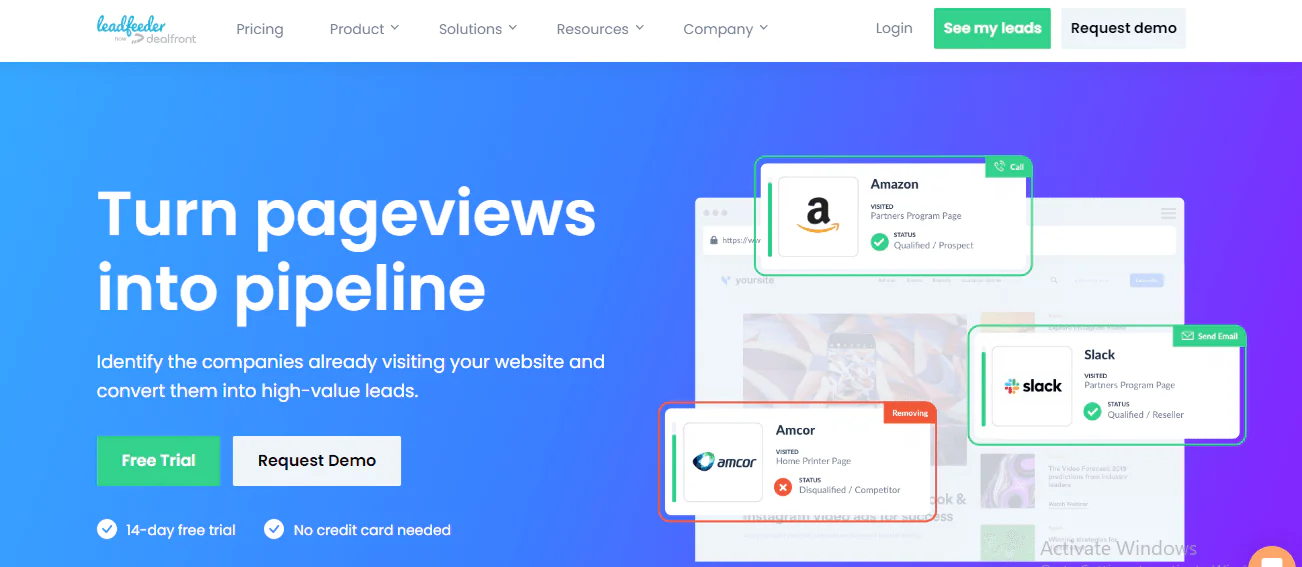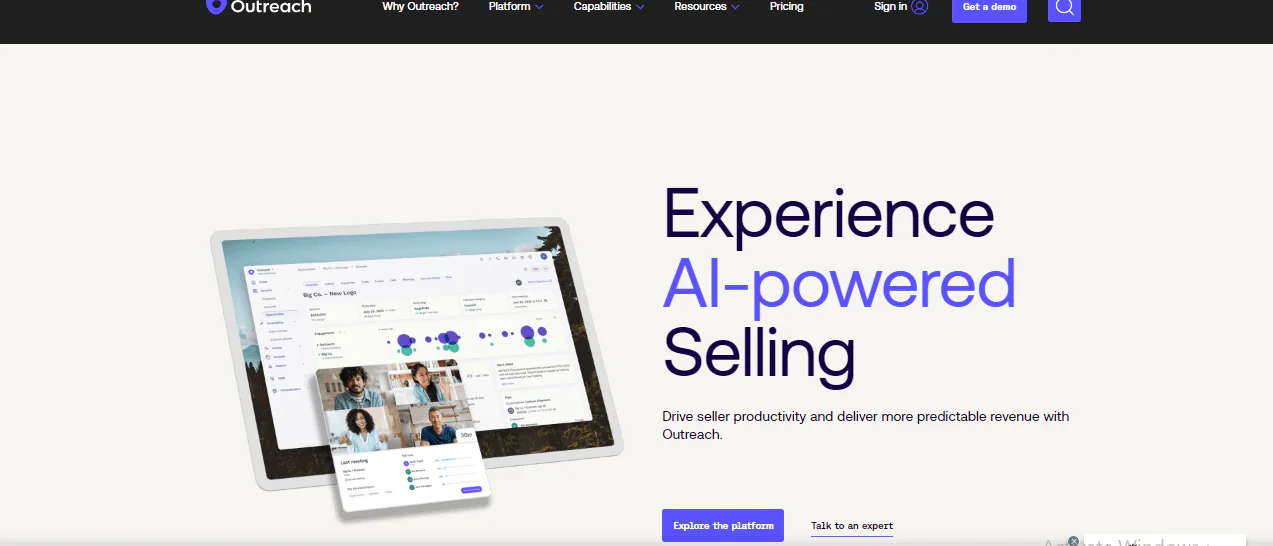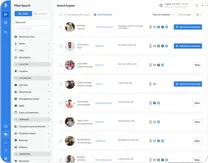
In the digital world, we’re in, companies that offer B2B SaaS products are always looking for ways to get more customers. Since the world of software is always changing, businesses have to stay updated.
This is the reason, B2B SaaS lead generation is about finding and reaching out to potential new customers effectively. It’s not just about advertising though. It’s about understanding what these businesses need and showing them the right solutions.
In this discussion, we’ll break down the basics of B2B SaaS lead generation and share some simple yet detailed strategies that can help businesses attract more clients and expand. Let’s start!
What is B2B SaaS?
B2B SaaS, or Business-to-Business Software as a Service, offers businesses cloud-based software solutions without the need for traditional installations. This approach provides flexibility, scalability, and cost savings.
Well, according to Fortune Business Insights, the global SaaS industry, valued at $113.82 billion in 2020, rose to $130.69 billion in 2021 and is projected to reach $716.52 billion by 2028.
Despite challenges like the pandemic, the demand remains strong, with 27% of business leaders increasing cloud spending due to COVID-19, as per a Flexera survey.
Additionally, organic searches drive 26.4% of SaaS website traffic, highlighting the importance of online visibility. Thus, with website load times directly impacting conversions, user experience is crucial.
This means B2B SaaS is not just about software but tailoring solutions to specific business needs while ensuring a seamless user experience.
Types of SaaS Leads
If you’re looking for the realm of SaaS lead generation, it’s essential to understand the 4 types of leads you might encounter. They are

Information Qualified Leads (IQLs)
These are individuals or businesses whom you’ll find at the start of a buyer’s journey that have shown interest in your content.
They do it by downloading a whitepaper or signing up for a newsletter. At this stage, they might not know much about your specific product or service.
Marketing Qualified Leads (MQLs)
These leads have engaged more deeply with your content and have shown a potential interest in your product.
They might have attended a webinar, filled out a contact form, or interacted with your marketing campaigns.
Sales Qualified Leads (SQLs)
These leads are the sales team has deemed ready for a direct sales approach. They’ve shown a clear interest in your product or service and are considered potential customers.
You can use lead scoring to know whether a lead is an SQL.
Product Qualified Leads (PQLs)
Last but not least, these are individuals or businesses that have used a free version or trial of your product and are considering an upgrade. Their interaction with your product makes them prime candidates for conversion.
Note: Try read more about email finder.
What Makes SaaS Lead Generation Different?

Let’s find out why SaaS lead generation is different. You will be convinced after reading this section.
1. Subscription-Based Model
SaaS operates predominantly on a subscription-based model, which fundamentally changes the customer-business relationship. Instead of a one-time transaction, micro SaaS companies aim for long-term customer engagement.
This requires continuous nurturing of leads and customers to ensure they see ongoing value in the service and choose to renew their subscriptions.
The lead generation process is not just about acquiring new customers but also about retaining existing ones.
2. Target Audience Complexity
The SaaS market is vast, catering to a wide array of industries and functions. From individual consumers looking for productivity tools to large corporations seeking enterprise solutions, the target audience varies greatly.
This diversity necessitates a more tailored and segmented approach to lead generation. Plus, it makes sure that the messaging and channels align with the specific needs and preferences of each segment.
3. High Competition and Market Saturation
With the low barrier to entry in the SaaS world, many companies offer similar solutions. This saturation means that businesses need to differentiate themselves not just through their product but also through their marketing and lead generation strategies.
It’s crucial to convey unique selling propositions (USPs) and value propositions effectively to stand out in a crowded market.
4. Longer Sales Cycles
SaaS products, especially those targeting enterprises, often involve significant investments in terms of time and money.
Potential customers often take their time evaluating options, testing demos, and ensuring the solution aligns with their needs. This extended decision-making process means that lead nurturing becomes an ongoing effort.
Consistent follow-ups and engagement are essential to keep potential clients interested and informed throughout this process.
5. Emphasis on Customer Education
Given the technical nature of many SaaS products, there’s a strong need to educate potential customers. This education isn’t just about how to use the product but also about the problems it solves and the value it offers.
Webinars, tutorials, e-books, and detailed content marketing play a pivotal role in this educational aspect of lead generation.
6. Importance of User Experience
The software’s user experience can make or break a SaaS company. A product that’s difficult to use or doesn’t meet user expectations can lead to high churn rates.
Therefore, lead generation strategies must not only attract potential customers but also set the right expectations about the product’s usability, features, and benefits.
7. Continuous Product Evolution
The SaaS industry is characterized by rapid innovation. Products frequently undergo updates, feature additions, and improvements.
Lead generation strategies must be agile, adapting to these changes to communicate the latest benefits and features to potential customers.
It’s also crucial to re-engage existing customers with these updates to encourage continued use and renewals.
8. Reliance on Metrics and Data
Data-driven decision-making is at the heart of SaaS businesses. Metrics like Monthly Recurring Revenue (MRR), Customer Acquisition Cost (CAC), and Churn Rate are vital indicators of business health.
Lead generation strategies need to be continuously monitored, optimized, and tweaked based on these and other relevant metrics to ensure maximum ROI and effectiveness.
Top 6 Ways to Generate B2B SaaS Leads
Generating B2B leads is essential for business growth, and it requires a strategic approach. Let’s find out some effective methods:

Content Marketing
Content marketing is more than just creating content. It’s about providing value. By crafting valuable and relevant content, you can position your business as an industry expert.
This not only attracts potential leads but also builds trust. Whether it’s insightful blog posts, comprehensive whitepapers, informative webinars, or engaging videos, the key is to address the specific needs and challenges faced by your target audience.
Regularly updating your content ensures you stay relevant and top-of-mind. In fact, 82% of marketers actively use content marketing, and over 60% measure the success of their content strategy through sales.
With the right approach, your content can keep you at the forefront of your industry.
Note: Try read more about Intent data providers.
Email Marketing
Email, with an average open rate of 21.33% across industries, remains one of the most direct ways to reach potential clients. But it’s not about bombarding them with messages. It’s about sending timely, targeted emails that resonate.
Newsletters can keep your audience informed, product updates can highlight new features or offers, and personalized emails can make the recipient feel valued.
A well-structured email campaign can nurture leads and guide them through the sales funnel.
Social Media
Social media platforms like LinkedIn, Twitter, and Facebook this time are not just for socializing. In fact, as of 2021, 69% of Americans use Facebook, and 98.3% of Facebook users access the app on mobile. They’re powerful tools for B2B SaaS leads.
By maintaining an active presence, sharing industry news, and engaging in meaningful conversations, you can expand your reach and connect with potential leads.
Also, it’s a platform to showcase your business’s culture and values.
Webinars and Online Events
Webinars and online workshops, with an average attendance rate of 40-50%, offer a dual benefit. They position your business as a thought leader while attracting leads interested in the topic you’re discussing.
Well, it’s really an opportunity to showcase your expertise. So, answer questions and engage with a wider audience, considering that 73% of B2B marketers and sales leaders say webinars are the best way to generate high-quality leads.
Of course, without geographical constraints!
Networking
While the digital realm offers numerous opportunities, there’s still immense value in face-to-face interactions.
According to HubSpot, 68% of professionals value face-to-face networking more than online. Attending industry conferences, workshops, and events allows you to meet potential leads in person.
Therefore, it’s an opportunity to understand their needs better, answer their queries, and leave a lasting impression.
Referral Programs
Your current customers can be your biggest advocates. If they’re satisfied with your product or service, they’re more likely to recommend it to others, with 92% of consumers trusting referrals from people they know.
Implementing a stripe referral program, where you incentivize your current customers to refer your business to others, can be a cost-effective way to generate new leads.
7 Best Practices to Improve B2B SaaS Lead Generation
Without any further due, let’s get into the 7 amazing B2B SAAS lead generation strategies for consistent growth.

1. Email Outreach with Automation
Emails remain a primary communication method for business professionals. Utilizing email outreach with automation tools can significantly extend your lead-generation efforts.
Automation software, like Salesmate, not only streamlines your email campaigns but also provides analytics on open rates, click-through rates, and conversion rates.
This data-driven approach ensures that your headlines, copy, and CTAs are continuously optimized for better engagement.
2. Chatbots for Instant Engagement
Chatbots, powered by AI, can be a game-changer for generating qualified SaaS leads. They not only provide immediate answers but can also be integrated with CRM systems to capture and categorize leads.
Salesmate’s Chat Journeys, for instance, can be customized to guide the user through a sales funnel, from initial inquiry to booking a demo.
3. Web Forms to Capture Leads
Web forms are more than just data capture tools. By integrating them with analytics tools, you can gain insights into user behavior.
Such as which content prompts users to sign up or which landing pages have the highest conversion rates.
4. Niche-specific Landing Pages
Dedicated landing pages can be further enhanced with video content, testimonials, and clear CTAs.
For example, a CRM software company can have separate landing pages for different industries, each highlighting features relevant to that industry.
5. Utilize SaaS Review Sites
Beyond just listing on platforms like G2 and Capterra, actively engaging with reviewers, addressing concerns, and highlighting positive reviews can significantly influence potential leads.
Offering incentives for reviews can also boost the number of reviews you receive.
6. Social Selling
Social selling is more than just posting content. It involves building relationships, joining industry-specific groups, and actively participating in discussions.
Tools like LinkedIn’s Sales Navigator can help in identifying and engaging with potential leads.
7. Referral Strategy
A structured referral program, offering incentives to existing customers for referring new clients, can amplify your lead generation. Highlighting these referrals in case studies can further enhance trust among potential leads.
8. Content Marketing for Thought Leadership
Content marketing is not just about producing content; it’s about establishing your brand as a thought leader in the SaaS industry.
By publishing insightful articles, whitepapers, and case studies, you can attract potential leads looking for solutions.
Moreover, hosting webinars and podcasts can provide a platform for direct interaction with potential clients. It allows you to address their pain points in real time.
9. SEO Optimization for Organic Traffic
Search engine optimization (SEO) ensures that your website ranks higher on search engines, driving organic traffic. You can attract leads actively searching for SaaS solutions by optimizing your website content, meta tags, and backlink profile.
Regularly updating your content and ensuring mobile optimization can further enhance your SEO efforts.
10. PPC Campaigns for Targeted Reach
Pay-per-click (PPC) campaigns, especially on platforms like Google Ads and LinkedIn, can provide a targeted approach to lead generation. By setting up well-researched ad campaigns, you can reach potential leads based on specific criteria like job titles, company size, and industry.
Moreover, retargeting campaigns can help you re-engage visitors who’ve previously interacted with your website.
Top 5 Tools That Help with B2B SaaS Lead Generation
Here are the top 5 tools to help with the lead generation for b2b saas.
1. Swordfish AI

Swordfish AI is a leading contact data platform tailored for B2B SaaS lead generation. It integrates seamlessly with major social platforms to extract contact details.
With Swordfish AI, users benefit from its multi-platform integration, especially with platforms like LinkedIn, Twitter, and Facebook. This ensures direct and accurate extraction of contact details.
The tool is renowned for its high data accuracy, ensuring that users receive reliable contact information. Furthermore, in the age of data privacy concerns, Swordfish AI stands out with its strict adherence to global data privacy regulations.
Ready to supercharge your lead generation efforts? Discover the power of Swordfish and take your B2B SaaS lead generation to new heights. Dig into Swordfish AI now!
2. HubSpot

HubSpot is an all-in-one inbound marketing, sales, and CRM suite designed to streamline the lead generation process. This tool offers a plethora of tools that cater to every step of the lead generation journey.
From creating captivating content to attract visitors, to deploying optimized landing pages and forms for conversions, HubSpot has it all.
Its real-time dashboard provides businesses with insights into lead activities, interactions, and conversions, ensuring effective lead nurturing.
3. Leadfeeder

Leadfeeder excels in harnessing the power of website analytics to uncover and profile potential leads, establishing itself as an indispensable resource for B2B organizations.
Through its seamless integration with key platforms, such as Google Analytics, Leadfeeder unlocks a wealth of insights into the behavior, preferences, and interactions of site visitors. This wealth of data enables businesses to fine-tune their outreach strategies with unprecedented precision.
The tool’s standout feature is its adeptness at identifying both the companies and individuals who visit your website, serving as a direct pipeline to a rich vein of potential leads. This capability significantly amplifies the efficiency and effectiveness of the lead generation process, making Leadfeeder a pivotal asset in any B2B company’s arsenal.
Leadfeeder Pricing
When it comes to Leadfeeder pricing, businesses will find that the platform offers a transparent and flexible pricing structure designed to accommodate the varied needs and budget constraints of B2B companies. This approach ensures that organizations of all sizes can access Leadfeeder’s powerful analytics and lead identification features, empowering them to elevate their marketing and sales strategies to new heights. With Leadfeeder, companies gain not just a tool, but a strategic partner in optimizing their outreach and maximizing their lead generation efforts.
4. Outreach.io

Outreach.io is a robust sales engagement platform focused on automating and streamlining communication with potential leads. It’s designed to simplify the sales process.
Moreover, this tool automates crucial tasks like email sequences and follow-ups, ensuring consistent engagement. Beyond automation, its analytics feature stands out, offering businesses insights into engagement metrics.
This helps in understanding which strategies resonate with the audience and which might need adjustments.
5. ZoomInfo

ZoomInfo is a comprehensive B2B contact database platform, that provides a wealth of information about businesses and professionals. Here, the vast repository offers businesses the opportunity to pinpoint potential leads based on specific criteria.
Whether it’s by industry, role, or region, the search capabilities are advanced and precise. Additionally, its integration with various CRM systems ensures a cohesive lead management process, from identification to conversion.
Final Words
That’s all. Remember that lead generation for B2B SaaS isn’t just a buzzword, it’s a fundamental pillar for business expansion.
As the wave of SaaS solutions continues to grow and influence various sectors, the challenge isn’t just about finding leads, but about connecting with the right ones.
By adopting effective strategies, companies can do more than just attract potential customers. They can engage with them, understand their needs, and establish lasting bonds.
Therefore, this deep connection is what sets the foundation for sustained success in the competitive landscape of B2B SaaS.
FAQs
How does B2B SaaS lead generation differ from B2C?
While B2B focuses on selling software solutions to businesses, B2C targets individual consumers. This means the strategies, channels, and messaging for B2B are often more specialized and tailored to address business needs.
Do offline methods still work for B2B SaaS lead generation?
While digital methods dominate the B2B SaaS landscape, offline methods like networking events, trade shows, and direct mail can still be effective, especially when combined with online strategies.
How can I measure the success of my lead-generation efforts?
Success can be gauged using key metrics like the lead conversion rate, which shows how many leads turn into customers, the cost per lead, the efficiency of your efforts, and the overall return on investment (ROI).


 View Products
View Products



